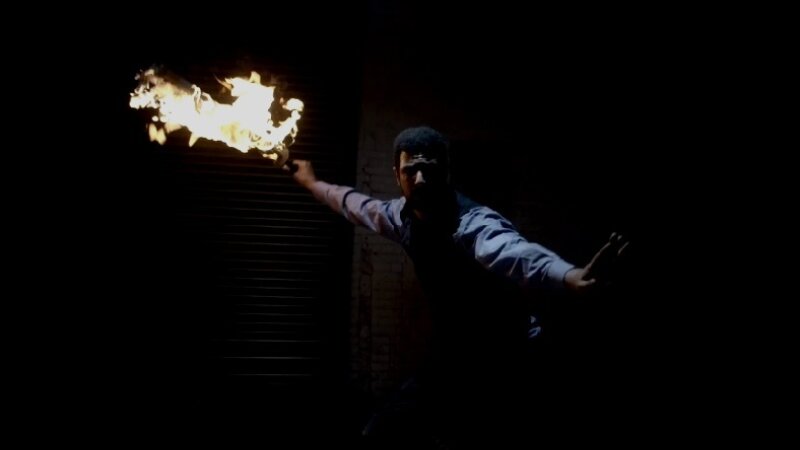Amon Tobin. Efrim Manuel Menuck. Fleet Foxes. Young Montana.
ISAM. Ninja Tune. Reviewer - Pete Hazell.
The master of found sound is back. He's still coaxing music out of machines and pushing dirt into percussion, but remains on a hiatus from drum breaks. Amon Tobin, the master beatsmith, sound designer and lord of dirt, has delivered another masterpiece of imagination in the form of ISAM. Listening to this album, full of what seems like living electricity and fluid, unpredictable gestures of countless sounds, you ask "How?" Then you see some of the toys he keeps: pin-point microphones, a world of objects and a big spongy keyboard to play it all on.
Tobin's last solo album Foley Room marked a clear sidestep from his previous five, all of which focused largely on sampling from vinyl and putting his mark on beat-driven styles. Foley Room was all about field recording and using sounds from anywhere as the core ingredients. Tobin wanted to explore this traditionally high-brow method of composition and work it in a way that made people move. ISAM is a big stride in a similar direction, with the collecting, controlling and morphing of sounds taken to a new level. This is very exciting and impressive, but it seems we must wait for more of those trademark Tobin breaks.
'Goto 10' and 'Bedtime Stories' sport the most solid head-nod appeal and distorted bass, with almost (dare I say it) dubstep characteristics. But the use of the 'D' word merely describes the kick-snare relationship on this album. Fear not, Tobin still very much owns his sound.
On first listen, I did miss his scattering drum cuts and rolling bully beats. ISAM seems to have a more lolloping feel to its percussion. 'Mass & Spring' and 'Lost & found' are full of the finest bass thumps and fractured snares around, but still allow plenty of space for the ever-present crescendos of digital rubble, folded crackles, blasts and scrapes that act like complicated wallpaper for the whole album. Too much wallpaper? Maybe for some. I think it will take some time to distinguish track from track in terms of sonic fidgeting, but it's worth a long train journey and some big headphones to get to know it all.
The cheeky, melodic side of Tobin's production appears on 'Kitty Cat', with its bouncy plucked chords and childish yet eerie female vocals. Meanwhile, 'Bedtime Stories' is representative of his ability to make something sound innocent before putting it through the processor.
If you want to be blown away by one man's ability to take everyday sounds like light bulbs, springs and squeaky chairs, and turn them into waves of crystal clear, beautifully arranged, slightly frightening, living audio, all without feeling highbrow, then this is the album for you. If you want to hear the same person chart the edges of electronica with haunting and aggressive atmospheres, this is also perfect. If you're looking for mighty and strange breaks made from crazy jazz drumming, it's the Amon Tobin back catalogue for you my friend.
|Plays "High Gospel". Constellation. Reviewer - Ben Dorey.
Efrim Manuel Menuck is perhaps not a name known to many, but over the past fifteen years it has been hard to ignore the immense influence of his projects on the musical landscape, most notably through the output of Godspeed You! Black Emperor. More recently Menuck has diversified, first as part of Thee Silver Mount Zion and the Vic Chesnutt Band and now as a solo artist. The most notable departure from Godspeed's sound in all these varied projects was the introduction of vocals from Efrim and others. This continues in his solo work, although the album also contains some haunting instrumentals.
Not one to pick snappy track names, Efrim's opener is titled 'Our Lady of Parc Extension and Her Munificent Sorrows'. Emerging from a bed of looping guitar layers and electronics, it showcases the saccharine euphoria Menuck has happened upon before with Godspeed, with major key vocals hiding disturbed lyrics, part folksy and part Animal Collective. The most striking element of the track is how different it sounds from most modern rock tracks, mainly due to production methods centered around analog processing, lending a hot tape warmth that creates a full, reedy sound. This quality of sound lingers in the next track, though the musical content leaps into darkness, affected voices chanting layers of lyrics like mantras over a creaking floor of electric noise, showcasing a talent for sound sculpting that goes beyond guitar trickery. By the song's close we are approaching vintage industrial techno as the elements grow in intensity over a crescendo of four to the floor drums and distorted hiss.
We are allowed a moment's respite in the next track, which has Menuck up to his old trick of using fairly typical rock melodies but completely reworking the style of delivery. Here we are treated to slowed down electric blues, with each note floating like a lily pad on an lake of rippling delays. Exquisite. This is followed by a delicate piano and vocal arrangement titled 'Heavy Calls And Hospitals Blues'. Though pleasant enough, this track features Efrim's vocals in a less adulterated state than elsewhere on the album and frankly I'm not too big a fan.
The second side opens with more reworkings of existing rock tropes in the excellent instrumental 'Heaven's Engine is a Dusty Ol' Bellows', before 'Kaddish for Chesnutt', a chilling elegy to Menuck's late collaborator. The track opens with three minutes of simplified instrumental that slips between the major and the minor, then descends into a swarm of discordant vocal drones before the entry of another repetitive layered vocal from Efrim develops into the body of the song, all tonal elements rhythmically uniting against the lilting background of field recordings and whirling synths. 'Chickadee's Roar pt.2' gives us some final moments of instrumental bliss, this time with recordings of the ocean and birdsong. It feels as if death, a looming theme in much of Menuck's output, has been acknowledged peacefully in this song, and the final track 'I Am No Longer A Motherless Child' marks an affirmation of faith in new life.
|Helplessness Blues. Sub Pop /Bella Union. Reviewer - Adam Kay.
You can suss out Fleet Foxes before hearing a single note of their music. It only takes one look at these hirsute, be-hatted, woolly-jumpered young men to determine the kind of songs they sing. Folk songs. Fleet, foxy folk songs. With a capital F.
Beardy weirdos they may be, but the Seattle sextet are absolute masters of their craft. Their self-titled 2008 debut was met with near-universal acclaim, and now they return with a second effort, Helplessness Blues.
As before, the Foxes' vocals are at the forefront. Their densely-layered, otherworldly harmonies at times sound more like the work of a choir of pagan monks than six guys from the Pacific north-west. It's certainly unique - at least in music created after about 1683 - but it is never less than mesmerising.
On the eerily atmospheric 'The Plains/Bitter Dancer', their voices echo as if bouncing off the walls of a haunted mansion. On 'Lorelai' they have the opposite effect: sweet and pretty, like a dawn chorus. On the booming 'Battery Kinzie', meanwhile, they sound like mates having a campfire singalong. You can practically hear them toasting the marshmallows.
The king of the Foxes is singer-songwriter Robin Pecknold. He has a superb set of lungs, but it's his eccentric lyrics that are his most interesting trait. His language is almost archaic - on 'Sim Sala Bim', he talks about someone who "ruffled the fur of the collie 'neath the table" - but it marks him out as a true original. "Both the slave and the empress/will return to the dirt, I guess," he shrugs on 'Montezuma', his voice brittle and angelic all the while.
Behind him, Pecknold's companions weave a rich musical tapestry. 'Bedouin Dress' is bolstered by a snaking violin line which lends it an air of exotic mysticism. Instrumental track 'The Cascades' is aptly-named, because its melodies sound as though they are tumbling down over one another. Over its eight dramatic minutes, 'The Shrine/An Argument' takes in wheezing organ, harp-like guitar and squeaking brass.
The album's centerpiece, however, is its title track. "I was raised up believing I was somehow unique," sings Pecknold, before the galloping guitars melt away to reveal a coda that is truly triumphant. Like the album as a whole, it is a thing of outstanding, life-affirming beauty.
With Helplessness Blues, Fleet Foxes have made a timeless record. Timeless because it sounds like it could have been made at any point in the last millennium, but timeless too because it is so good, so impossibly perfect, that it will probably be played well into the next one. The word 'masterpiece' may be a bit strong, but this album is folkin' fantastic.
|Limerence. Alpha Pup Records. Reviewer - Fred Oxby.
The debut LP by Young Montana? comes in the form of Limerence, an 11-track album on Alpha Pup Records, which has also released such luminaries as Daedalus, Free The Robots, The Gaslamp Killer and Jaga Jazzist. His rise onto such a prestigious imprint has been swift too, with this record coming only a short year after being named Mary Anne Hobb's Favourite Unsigned Artist of 2010.
Like much so-called 'bass' music, Limerance draws influence from a variety of not-so-recent musical fauna like hip hop, dubstep, garage and house, melding the styles together to form an altogether modern package. Detuned vocals are woven into G-funk grooves, while pitched kick drums and LFO-ridden bass provide the backbone. The production values are high and the beat making is particularly impressive, providing interest throughout the record. Sometimes, though - as on the track 'Hot Heathrr', which features a very busy lead synth line - I think Young Montana? goes too far with his aesthetic, crushing too many elements into each moment. But these moments are few and far between, and in general this is a very strong debut.
At his best, Montana offers sensitive melody and intriguing drum programming. 'Mynnd', one of my highlights of the record, combines driving beats with haunting melody to create a delicate and worthwhile listen. 'Legwrap', another strong one, features a distinctly catchy pitched synth and deep drums to create a complex and satisfying piece. Final track 'Connct' opens with an infectious synth line and a rather amusing garage rework of Tchaikovsky's 'Dance of the Sugar Plum Fairy', showing that there is humour here as well.
While this musical melting pot does yield some impressive results, Limerence sometimes lacks enough continuity for it to really gel together. As well produced as this record may be, occasionally the melodies feel a little too off-kilter and do not complement the overall flow of the music as well as they might on a shorter record.
Influences taken from the likes of Baths, Flying Lotus and Gold Panda are undeniable, and although Young Montana's music is not necessarily original, it is worth a listen. He has occasionally missed the target with some of these tunes, but has nonetheless made a strong opening release and one with a commendable amount of depth for a 20-year-old from Coventry.
)




